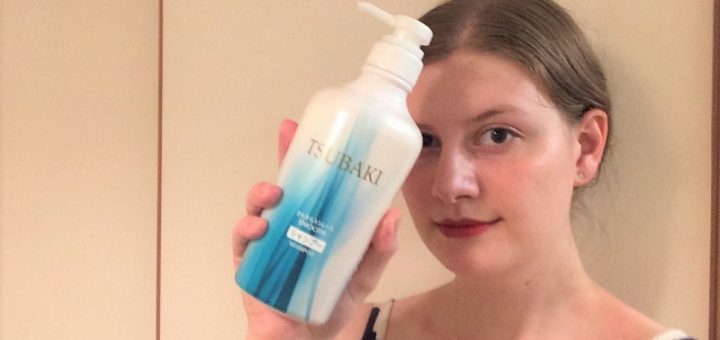Tsubaki Smooth Shampoo Review

Hi guys. Maybe you remember that I reviewed Shiseido’s Tsubaki Premium Repair Mask before. This time, here’s a quick review of their “smooth” shampoo from the same Tsubaki range.
Packaging
The Tsubaki Smooth Shampoo comes in a large blue and white bottle with a pump. It promises sleek, straight hair.

It says it includes extracts of camellia oil (tsubaki means camellia in Japanese!), lemon, soy protein, royal jelly and botanical essence. I have to admit I’m not sure what they mean by botanical essence…
There are two other shampoos available from the same Tsubaki range, one with a red bottle (“moist”) and one that’s pink (“volume”) so you can pick the one that best suits your needs. They all contain the five ingredients I mentioned.
My impressions
In general, Japanese people wash their hair every single day, so Japanese shampoos are more gentle than those available in some other countries. Recently I’ve been washing my hair most days because it’s still very hot in Kyoto and my head gets sweaty easily (><)
The Tsubaki Smooth Shampoo has a soft, flowery smell. I let my hair dry naturally before taking these pictures. The texture feels very smooth and there’s a nice gentle wave. By the way, I applied a treatment (Pantene’s Miscellar Treatment) to the bottom half of my hair, but the top also felt silky and soft.


My hair is not really any straighter than usual, but I guess when they said that on the bottle they mean for Asian hair XD I’m happy with the wavy style anyway.
Summary
I was very impressed by this shampoo! As I said it’s quite light and gentle, so if you have very oily hair or prefer only to wash it every couple of days, it may not be the best for you. But for me it’s worked well at tackling the slightly lank and greasy feeling I sometimes get at the roots even just after washing. I think I’ll be buying this one again.
Bonus hair-styling tip!
Recently I bought some spiral hairpins (“spin pins”) and I’ve found they make it SO much easier to put your hair up in a bun, especially by yourself.

A one-minute bun with spin pins (you can hide them better than I did here, but that takes a bit of practice)
I can’t believe how many years I didn’t know about these pins; they’re so handy and not too expensive either. You can find tutorials on Youtube, but essentially you twist the pin in one way to fix your hair in place, then twist in the reverse direction to take it out.
Instead of using ten normal hairpins I use about three of these and my hairdo feels much more stable. Unfortunately in Japan I can only find them in black as you might expect… but when I go back to Europe I plan to buy some in a colour closer to my shade. If you like to wear your hair up, I really recommend these pins!













